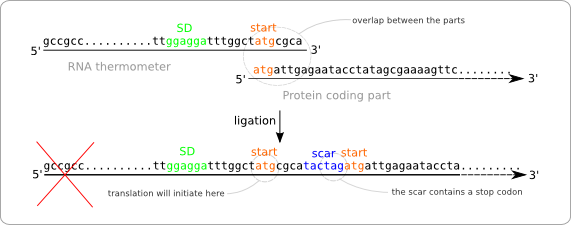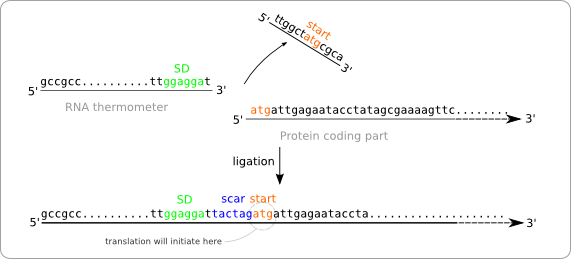Team:TUDelft/Temperature design
From 2008.igem.org
Bavandenberg (Talk | contribs) (→Notes) |
Bavandenberg (Talk | contribs) |
||
| Line 9: | Line 9: | ||
First approach three excisting RNA thermometers and one artificial RNA thermometer based on G-quadruplex. | First approach three excisting RNA thermometers and one artificial RNA thermometer based on G-quadruplex. | ||
| - | ==Scar problem== | + | ==Phase I: Introducing an RNA thermometer into e. coli== |
| + | |||
| + | Introduction part | ||
| + | |||
| + | ===Scar problem=== | ||
Turning the RNA thermometer sequences into standard biobricks is not as straightforward as adding a prefix and suffix to the found sequences. The reason for this is that the start codon of the protein coding part following the RNA thermometer is also part of the RNA thermometer sequence (figure ... sequences met atg overlap). The problem with this approach is that the ligation of the two parts results in a sequence containing two start codons with in between the scar (figure ... wrong situation sticking together two parts). The first of these start codon (the one on the RNA thermometer) will act as the initiation point for the translation, because of its distance to the Shine Dalgarno sequence. At first some extra amino acids will be added to the protein, but even worse, the protein will not be translated at all. This is because of the scar that contains a stop codon. So the translation will already end before the protein coding region is reached. | Turning the RNA thermometer sequences into standard biobricks is not as straightforward as adding a prefix and suffix to the found sequences. The reason for this is that the start codon of the protein coding part following the RNA thermometer is also part of the RNA thermometer sequence (figure ... sequences met atg overlap). The problem with this approach is that the ligation of the two parts results in a sequence containing two start codons with in between the scar (figure ... wrong situation sticking together two parts). The first of these start codon (the one on the RNA thermometer) will act as the initiation point for the translation, because of its distance to the Shine Dalgarno sequence. At first some extra amino acids will be added to the protein, but even worse, the protein will not be translated at all. This is because of the scar that contains a stop codon. So the translation will already end before the protein coding region is reached. | ||
| Line 27: | Line 31: | ||
Having designed sequences that have the same secondary structure does not guarantee the same functionality. The pairing nucleotides around the Shine Dalgarno region are changed, so the temperature needed to expose the Shine Dalgarno sequence will probably be changed. Tests will have to point out what the switching temperature of the RNA thermometer parts will be. This is of course if the parts work at all. There are probably a lot of factors (more than the predicted secondary structure can tell us) that play a role in the temperature sensing process, also many that we don't now of. Even one mutation can already lead ... | Having designed sequences that have the same secondary structure does not guarantee the same functionality. The pairing nucleotides around the Shine Dalgarno region are changed, so the temperature needed to expose the Shine Dalgarno sequence will probably be changed. Tests will have to point out what the switching temperature of the RNA thermometer parts will be. This is of course if the parts work at all. There are probably a lot of factors (more than the predicted secondary structure can tell us) that play a role in the temperature sensing process, also many that we don't now of. Even one mutation can already lead ... | ||
| - | == Changing the temperature threshold == | + | ===References=== |
| + | |||
| + | == Phase II: Changing the temperature threshold of the RNA thermometer == | ||
Introduction... | Introduction... | ||
| Line 44: | Line 50: | ||
De Smit and Van Duin<sup id="cite_ref-1"> [[Team:TUDelft/Temperature_design#cite_note-1 |[1]]] </sup> show a correlation between the level of expression and the free energy of the secondary structure in the Shine Dalgarno region. | De Smit and Van Duin<sup id="cite_ref-1"> [[Team:TUDelft/Temperature_design#cite_note-1 |[1]]] </sup> show a correlation between the level of expression and the free energy of the secondary structure in the Shine Dalgarno region. | ||
| - | |||
| - | |||
<div class="toggler"> | <div class="toggler"> | ||
| Line 71: | Line 75: | ||
</div> | </div> | ||
| - | = References = | + | === References === |
<div class="references"> | <div class="references"> | ||
Revision as of 07:20, 1 September 2008
>> work in progress
Contents |
Parts Design
First approach three excisting RNA thermometers and one artificial RNA thermometer based on G-quadruplex.
Phase I: Introducing an RNA thermometer into e. coli
Introduction part
Scar problem
Turning the RNA thermometer sequences into standard biobricks is not as straightforward as adding a prefix and suffix to the found sequences. The reason for this is that the start codon of the protein coding part following the RNA thermometer is also part of the RNA thermometer sequence (figure ... sequences met atg overlap). The problem with this approach is that the ligation of the two parts results in a sequence containing two start codons with in between the scar (figure ... wrong situation sticking together two parts). The first of these start codon (the one on the RNA thermometer) will act as the initiation point for the translation, because of its distance to the Shine Dalgarno sequence. At first some extra amino acids will be added to the protein, but even worse, the protein will not be translated at all. This is because of the scar that contains a stop codon. So the translation will already end before the protein coding region is reached.
To solve this problem we have to alter the sequence of the RNA thermometer. Alteration of the protein coding part is of course no option because we are aiming for a standard part that can be combined with any other standardized protein coding part. So these parts, that always start with a start codon should be kept intact. The simple solution is to chop of the last part of the RNA thermometer sequence, which will be replaced by the scar and the start of the protein coding part after ligation (figure ... solution without scar adaption).
But this results in a new problem. The alteration of the RNA thermometer sequence also changes its secondary structure and that will also affect its function as temperature sensor (figure ... change of secondary structure). To resolve this we made some extra alteration in the RNA thermometer sequence at the opposite position of the scar in order to regain the original secondary structure.
We applied this procedure to three of the four RNA thermometers that we got from the literature. We used the Vienna RNAfold webserver to predict the secondary structure of the original RNA thermometer and the altered sequence. We regained the original secondary structure using a trial and error approach adding different nucleotides opposite of the added scar...
The fourth RNA thermometer, the artificial one based on the G-quadruplex structure, will loose its temperature sensitivity when the scar is introduced into the sequence. It happens to replace multiple G nucleotides that make up the G-quadruplex structure which is responsible for the temperature sensitivity.
Having designed sequences that have the same secondary structure does not guarantee the same functionality. The pairing nucleotides around the Shine Dalgarno region are changed, so the temperature needed to expose the Shine Dalgarno sequence will probably be changed. Tests will have to point out what the switching temperature of the RNA thermometer parts will be. This is of course if the parts work at all. There are probably a lot of factors (more than the predicted secondary structure can tell us) that play a role in the temperature sensing process, also many that we don't now of. Even one mutation can already lead ...
References
Phase II: Changing the temperature threshold of the RNA thermometer
Introduction...
In order to be able to design an RNA thermometer with a specific temperature threshold, we need to know which factors are of influence on this threshold. The most important one is probably the secondary structure around the Shine Dalgarno sequence. The basic principle of an RNA thermometer is that heat, or a rise in temperature, is needed to expose the Shine Dalgarno sequence by melting the part of the secondary structure containing this sequence. It sounds logical that the temperature threshold can be increased by incorporating nucleotides that form strong base pairs within the Shine Dalgarno region. This will result in a more stable helix for which a higher temperature is needed to make it unstable, i.e. melt. Incorporating nucleotides that has weaker base-pairing strength within the Shine Dalgarno region will have the opposite effect. The helix will become less stable and less heat will be needed to melt it. This way the temperature threshold at which the translation will initiate will drop.
Two facts that enforce this assumption... First, aligning the sequences of the different types of RNA thermometers produces conserved regions around the SD region. Second, it is shown by De Smit and Van Duin (reference) that there is a strong correlation between translation efficiency and the stability of the helix containing the Shine-Dalgarno region and the initiation codon.
But will this region on itself be enough to have a working RNA thermometer? Looking at the consensus structure of the ROSE and PrfA RNA thermometer, it can be seen that there are other regions within the structure that are highly conserved. This indicates that these regions might also be of importance to the functioning of the RNA thermometer. It is still unknown if the stem-loops not containing the SD are of any help with the opening of the SD region (reference).
Pseudoknot analysis.
figures...(consensus structures, highly conserved SD regions)
De Smit and Van Duin [1] show a correlation between the level of expression and the free energy of the secondary structure in the Shine Dalgarno region.
test
test test test
test
test test test
test
test test test
References
- ^ De Smit M H, Van Duijn J (1990). "Secondary structure of the ribosome binding site determines translation efficiency: A quantitative analysis". PNAS, 1990-10, vol.87, no.19, 7668-7672. [http://www.ncbi.nlm.nih.gov/pubmed/2217199 PMID:2217199]
- ^ Hoe N P, Goguen J D (1993). "Temperature sensing in Yersinia pestis: Translation of the LcrF activator protein is thermally regulated". J Bacteriol, 1993 December, 175(24), 7901-7909. [http://www.ncbi.nlm.nih.gov/pubmed/7504666 PMID:7504666]
- ^ Chowdhurry S, Maris C, Allain F H T, Narberhaus F (2006). "Molecular basis for temperature sensing by an RNA thermometer". The EMBO Journal, 2006, 25, 2487–2497. [http://www.ncbi.nlm.nih.gov/pubmed/16710302 PMID:16710302]
- ^ Nocker A, Hausherr T, Balsiger S, Krstulovic N, Hennecke H, Narberhaus F (2001). "A mRNA-based thermosensor controls expression of rhizobial heat shock genes". Nucleic Acids Research, 2001 December 1, 29(23):4800-4807. [http://www.ncbi.nlm.nih.gov/pubmed/11726689 PMID:11726689]
- ^ Balsiger S, Ragaz C, Baron C, Narberhaus F. "Replicon-specific regulation of small heat shock genes in Agrobacterium tumefaciens". Journal of Bacteriology, October 2004, p. 6824-6829, Vol.186, No.20. [http://www.ncbi.nlm.nih.gov/pubmed/15466035 PMID:15466035]
- ^ Waldminghaus T, Heidrich N, Branti S, Narberhaus F (2007). "FourU: a novel type of RNA thermometer in Salmonella". Molecular Microbiology, Volume 65, Issue 2, 413-424. [http://www.ncbi.nlm.nih.gov/pubmed/17630972 PMID:17630972]
- ^ Johansson J, Mandin P, Renzoni A, Chiaruttinni C, Springer M, Cossart P. "An RNA thermosensor controls expression of virulance genes in Listeria monocytogenes". Cell , Volume 110 , Issue 5 , 551-561. [http://www.ncbi.nlm.nih.gov/pubmed/12230973 PMID:12230973]
 "
"

